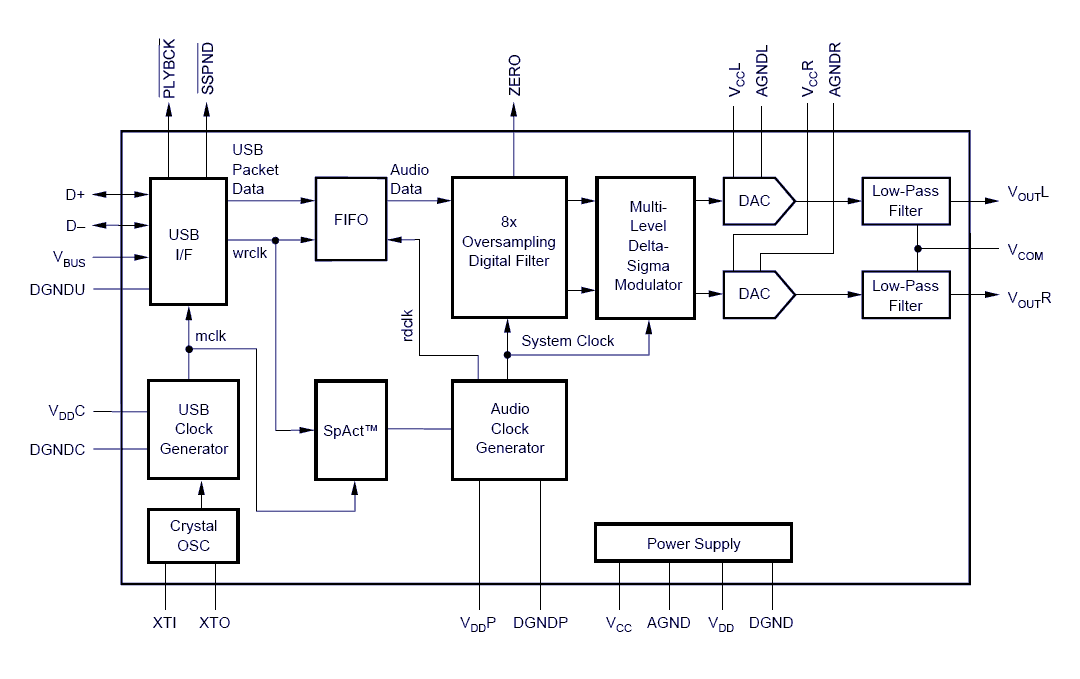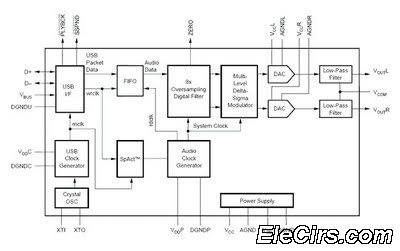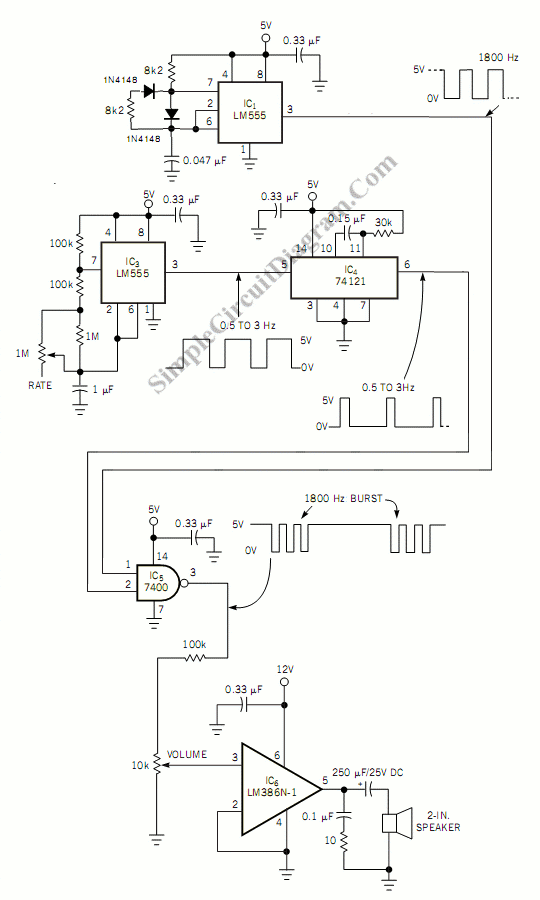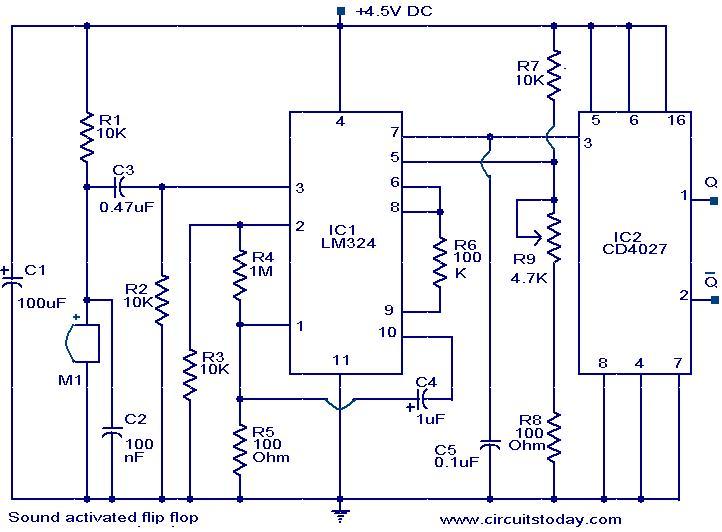
usb sound card with pcm 2702

Designing and building a USB sound card is no longer a headache with the PCM2702 integrated circuit from Texas Instruments. The PCM2702 is a digital-to-analog converter (DAC) that features digital-to-analog output channels. The integrated interface controller of the PCM2702 complies with USB 1.1 standards. The IC handles sampling rates of 44.1 kHz and 48 kHz. It includes helpful features such as an on-chip clock generator, digital attenuator, playback flag, suspend flag, zero flag, and mute function. This circuit is plug-and-play and does not require any driver software for Windows XP and Windows Vista operating systems. The circuit receives audio from the USB through the D+ and D- pins of the PCM2702, with data transfer occurring at full speed. The decoded audio signals are available at the VOUTL and VOUTR pins of the IC. A 12 MHz crystal is connected between the XT0 and XT1 pins of the IC. The VBUS (USB bus power) pin and DGND (digital ground) pin of the IC are connected to the +5V and ground pins of the USB, respectively. The circuit operates at +5V DC and +3.3V DC, with voltages derived from the USB port using low-dropout (LDO) voltage regulators (not shown in the circuit).
The PCM2702 integrated circuit serves as a versatile solution for USB audio applications. It simplifies the design of USB sound cards by integrating essential functionalities into a single chip. The digital-to-analog conversion is performed with high fidelity, ensuring that audio playback is clear and accurate. The compliance with USB 1.1 standards allows for broad compatibility with various devices without the need for additional drivers, enhancing user convenience.
The circuit design incorporates the PCM2702’s D+ and D- pins, which are critical for USB data communication. The full-speed data transfer capability ensures that audio signals are transmitted efficiently, maintaining the integrity of the sound quality. The output pins, VOUTL and VOUTR, provide stereo audio signals that can be connected directly to speakers or an audio amplifier.
The inclusion of a 12 MHz crystal oscillator is vital for the proper timing and functioning of the PCM2702. This clock signal is necessary for synchronizing the digital processing within the IC. The power supply connections to the VBUS and DGND pins are crucial for the operation of the device, as they provide the necessary voltage levels for the internal circuitry.
Additionally, the use of low-dropout voltage regulators to derive the operating voltages from the USB port enables efficient power management. This feature is particularly beneficial in portable applications where battery life is a concern. The design can be further enhanced by adding filtering capacitors to the power supply lines to minimize noise and improve audio performance.
Overall, the PCM2702 represents a robust and efficient solution for creating USB sound cards, providing a complete audio processing solution in a compact package. The integration of multiple functions into a single IC streamlines the design process, making it accessible for engineers and hobbyists alike.Designing and building a USB sound card longer a head ache got the PCM 2702 integrated circuit from Texas Instruments. The PCM2702 is an integrated bit digital to analog converter that has digital to analog output channels.
The integrated interface controller of PCM2702 is compliant to the USB. 0 standards. The IC handle sampling rates of KHz, 44. 1 KHz and KHz. The IC of helpful like on-chip clock generator, digital attenuator, play back flag, suspend flag, zero flag, mute etc. is that this circuit is plug & play and doesn`t any driver software for Windows XP and Windows Vista operating systems.
The circuit gets and audio from the USB through the D+ and D- pins of the PCM2702 all transferring is at full speed. The decoded audio signals at the VOUTL and VOUTR pins of the IC. The 12MHz crystal is connected between the XT0 and XT1 pins of the IC. The VBUS (USB bus power) pin and DGND (digital ground) pins of the IC are connected to the +5V and ground pins of the USB respectively.
The circuit +5V DC and +3. 3V DC for operation and voltages derived from the USB port using LDO (low drop out) voltage regulators (not shown in circuit). 🔗 External reference
The PCM2702 integrated circuit serves as a versatile solution for USB audio applications. It simplifies the design of USB sound cards by integrating essential functionalities into a single chip. The digital-to-analog conversion is performed with high fidelity, ensuring that audio playback is clear and accurate. The compliance with USB 1.1 standards allows for broad compatibility with various devices without the need for additional drivers, enhancing user convenience.
The circuit design incorporates the PCM2702’s D+ and D- pins, which are critical for USB data communication. The full-speed data transfer capability ensures that audio signals are transmitted efficiently, maintaining the integrity of the sound quality. The output pins, VOUTL and VOUTR, provide stereo audio signals that can be connected directly to speakers or an audio amplifier.
The inclusion of a 12 MHz crystal oscillator is vital for the proper timing and functioning of the PCM2702. This clock signal is necessary for synchronizing the digital processing within the IC. The power supply connections to the VBUS and DGND pins are crucial for the operation of the device, as they provide the necessary voltage levels for the internal circuitry.
Additionally, the use of low-dropout voltage regulators to derive the operating voltages from the USB port enables efficient power management. This feature is particularly beneficial in portable applications where battery life is a concern. The design can be further enhanced by adding filtering capacitors to the power supply lines to minimize noise and improve audio performance.
Overall, the PCM2702 represents a robust and efficient solution for creating USB sound cards, providing a complete audio processing solution in a compact package. The integration of multiple functions into a single IC streamlines the design process, making it accessible for engineers and hobbyists alike.Designing and building a USB sound card longer a head ache got the PCM 2702 integrated circuit from Texas Instruments. The PCM2702 is an integrated bit digital to analog converter that has digital to analog output channels.
The integrated interface controller of PCM2702 is compliant to the USB. 0 standards. The IC handle sampling rates of KHz, 44. 1 KHz and KHz. The IC of helpful like on-chip clock generator, digital attenuator, play back flag, suspend flag, zero flag, mute etc. is that this circuit is plug & play and doesn`t any driver software for Windows XP and Windows Vista operating systems.
The circuit gets and audio from the USB through the D+ and D- pins of the PCM2702 all transferring is at full speed. The decoded audio signals at the VOUTL and VOUTR pins of the IC. The 12MHz crystal is connected between the XT0 and XT1 pins of the IC. The VBUS (USB bus power) pin and DGND (digital ground) pins of the IC are connected to the +5V and ground pins of the USB respectively.
The circuit +5V DC and +3. 3V DC for operation and voltages derived from the USB port using LDO (low drop out) voltage regulators (not shown in circuit). 🔗 External reference





